Acupuncture
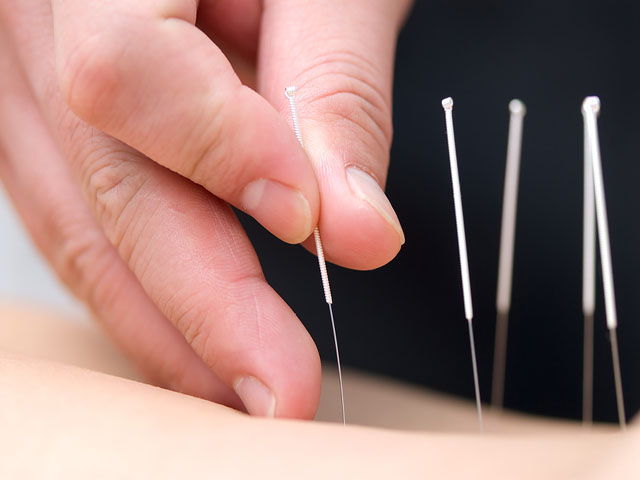
What is acupuncture?
Acupuncture is one of the four pillars of traditional Chinese medicine: Acupuncture, TuiNa, Herbal Medicines and QiGong. Acupuncture is an ancient technique with which a skilled acupuncture physician or practitioner inserts hair-thin needles into specific points on the body to prevent or treat illness. Practiced over 2,500 years in China, where it originated, acupuncture is part of the holistic system of TCM. Since abnormal energy or Qi flows are thought to cause disease, acupuncture aims to restore health by enhancing and/or readjusting the flows of Qi.
While acupuncture was mentioned in Western medical texts more than a hundred years ago (Sir William Osler’s Principles and Practice of Medicine, published in 1892, recommended it for sciatica and lumbago), it wasn’t until 1971 that U.S. citizens really became aware of the technique. It was then that New York Times reporter James Reston, stricken with appendicitis while in Beijing, was treated successfully with acupuncture for post-surgical pain. “I’ve seen the past, and it works!” written by Restonin a front page of Times story.
This exposure came at a time when many Americans were looking for a more holistic, naturalistic approach to health care, and it caused quite a stir among the Western medical community. Since then acupuncture has become a widely accepted form of treatment in the U.S., practiced by MDs and DOs (doctors of osteopathy) who have received special training in its methods, as well as by practitioners who specialize only in the technique.
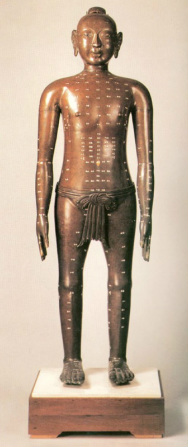
How does acupuncture work?
According to the principles of TCM, Qi flows through the body via 14 primary meridians or channels. To strengthen the Qi flow, or remove blockages in the meridians, an acupuncturist inserts a number of tiny, sterile, flexible needles just under the skin at certain specific points(acupoints) along the channels. There are thousands of acupoints along the meridians, which are associated with specific internal organs or organ systems. If you are suffering from nausea, for example, needles might be inserted into acupoints on your wrist, while a vision problem might be treated with needles in the foot (Ear, scalp, and hand points are also commonly used by some practitioners). TCM proponents believe that acupuncture stimulates the body’s internal regulatory system and nurtures a natural healing response.
Same as TCM, acupuncture was developed on the basis of experience. There have been trillions of successful cases effective for a score of disorders in the history of acupuncture practice. Although Western science has neither proven nor accepted the notion of Qi, accumulating evidence indicates that acupuncture leads to real physiologic changes in the body. Numerous studies have shown, for
example, that inserting needles into the skin stimulates nerves in the underlying muscles. This stimulation, researchers suggest, sends impulses up the spinal cord to a relatively primitive part of the brain known as the limbic system, as well as to the midbrain and the pituitary gland. Somehow that signaling leads to the release of endorphins and monoamines, chemicals that block pain signals in the spinal cord and brain.
In one study, researchers using brain imaging discovered that acupuncture can alter blood circulation within the brain, increasing the blood flow to the thalamus, the area of the brain that relays pain and other sensory messages. Hundreds of studies are now ongoing in the U.S. and elsewhere seeking to prove the usefulness of acupuncture for various ailments.
Expection and Causion:
On your first visit to an acupuncturist, the practitioner will take a thorough medical history, then may touch pulses on each wrist, examine your tongue, take note of how your breath and body smell, and “palpate” (or feel) certain areas of your body. Depending on your ailment, you may also have your first acupuncture treatment at this time. In general, visits occur once or twice a week over several months until therapeutic results are achieved.
While the needles can feel uncomfortable at times, they rarely hurt. They are very thin (only about three times the thickness of a human hair and much finer than the hypodermic needles used to give injections) and are designed to enter the skin with little resistance. Once the needles are inserted (generally from one to 15 are used), the acupuncturist may twist them manually or send a weak electrical current through them to increase the energy flow. The needles may be left in for 15 to 40 minutes, depending on the ailment. Some practitioners also use moxibustion, which involves burning herbs (primarily the dried herb mugwort), near acupoints, to hasten healing.
Different people experience different sensations from acupuncture. Some describe a tingling pins-and-needles feeling, others may feel numbness or nothing at all. Most find the sessions relaxing, and some fall asleep during or immediately after treatment. Some patients notice rapid improvement after just a few sessions. In those whose conditions have taken years to develop, treatment may take longer.
While scores of illnesses have traditionally been treated by acupuncture in Asia, its primary use in the United States has been to relieve chronic pain caused by such ailments as arthritis, headache, PMS, and back pain, and to assist withdrawal from addictions such as drug and alcohol dependency. Some practitioners also received reasonable good effects for treating a number of chronic internal medical disorders. Now more innovative applications for acupuncture are being explored by both conventional and alternative practitioners, including its use as an analgesic to reduce pain during surgery.
In 1997, an advisory panel for the National Institutes of Health (NIH) evaluated hundreds of acupuncture studies and concluded that the therapy is an effective treatment for postoperative pain after dental surgery and for nausea induced by chemotherapy, pregnancy (“morning sickness”), and anesthesia. The NIH panel also called acupuncture a useful adjunct and acceptable treatment for a variety of conditions, including fibromyalgia, stroke rehabilitation, headache, and carpal tunnel syndrome.
Similar to any other medical treatments, acupuncture may also have side effects. Please be sure to read the patient consent form carefully and do tell your acupuncture physician if you have or have had Hepatitis B and other contagious diseases, or if you are pregnant or think you may be. People on anticoagulant drugs may bleed easily even when thin acupuncture needles are inserted. Consult your primary physician before having acupuncture if you are on such medication.
Chinese Herbal Medicine
 Chinese herbal medicine is one the of major components of TCM. It equals the Pharmacy in the conventional Western medicine. The difference is that in the ancient time, there were no synthetic drugs, and all the drugs then came from nature. They were collected, processed, and tested for medical use. The bad and ineffective ones were eliminated, and the successful ones survived during the thousands of years practice in history. There are 493 commonly used herbs that can be classified into 20 different categories. The greatest work in Chinese herbal medicine was published in 1578, named “Ben Cao Gang Mu“. This book collected 1,892 herbs with 11,096 remedies, and is sometimes referred to as the Bible of Chinese Herbs. “Pu Ji Fang“, the biggest book of herbal remedies in history described 61,739 remedies that covered treatments for almost all the known diseases at that time though there are approximately 236 primary remedies with 186 amended ones that are commonly used.
Chinese herbal medicine is one the of major components of TCM. It equals the Pharmacy in the conventional Western medicine. The difference is that in the ancient time, there were no synthetic drugs, and all the drugs then came from nature. They were collected, processed, and tested for medical use. The bad and ineffective ones were eliminated, and the successful ones survived during the thousands of years practice in history. There are 493 commonly used herbs that can be classified into 20 different categories. The greatest work in Chinese herbal medicine was published in 1578, named “Ben Cao Gang Mu“. This book collected 1,892 herbs with 11,096 remedies, and is sometimes referred to as the Bible of Chinese Herbs. “Pu Ji Fang“, the biggest book of herbal remedies in history described 61,739 remedies that covered treatments for almost all the known diseases at that time though there are approximately 236 primary remedies with 186 amended ones that are commonly used.
Although Chinese herbs are not purified synthetic compounds as most Western medicinal products, some commonly used herbs are as effective as claimed, if used properly. Certain herbal formulas are well established based on thousands of years of experience. A better known example comes from the current standard therapy worldwide for falciparum malaria, which is the artemisinin-combination therapies. The major component of the combination is the artemisinin, which is a compound isolated from a TCM herb, artemisia annua, that has been used for antimalaria therapy in TCM practice for over a thousand years.
One of the special expertise in addition to acupuncture in our Clinic is the highly proficient, exquisite and sometimes unique use of Chinese herbs. In combination of acupuncture, the effectiveness has brought in many surprises for patients.
Moxibustion
 Moxibustion is a complementary component of acupuncture, which is an external method of preventing and treating disease by ignition of moxa to stimulate the points. Moxa is an herb preparation mainly made of moxa leaves that smell fragrant and is easy to be ignited. By smoldered on or held near to the acupuncture point moxibustion has the functions to warm channel (where Qi/energy flows) and expel cold, to smooth flow of Qi and blood, and subdue swelling and disperse accumulation of pathogen.
Moxibustion is a complementary component of acupuncture, which is an external method of preventing and treating disease by ignition of moxa to stimulate the points. Moxa is an herb preparation mainly made of moxa leaves that smell fragrant and is easy to be ignited. By smoldered on or held near to the acupuncture point moxibustion has the functions to warm channel (where Qi/energy flows) and expel cold, to smooth flow of Qi and blood, and subdue swelling and disperse accumulation of pathogen.
Cupping
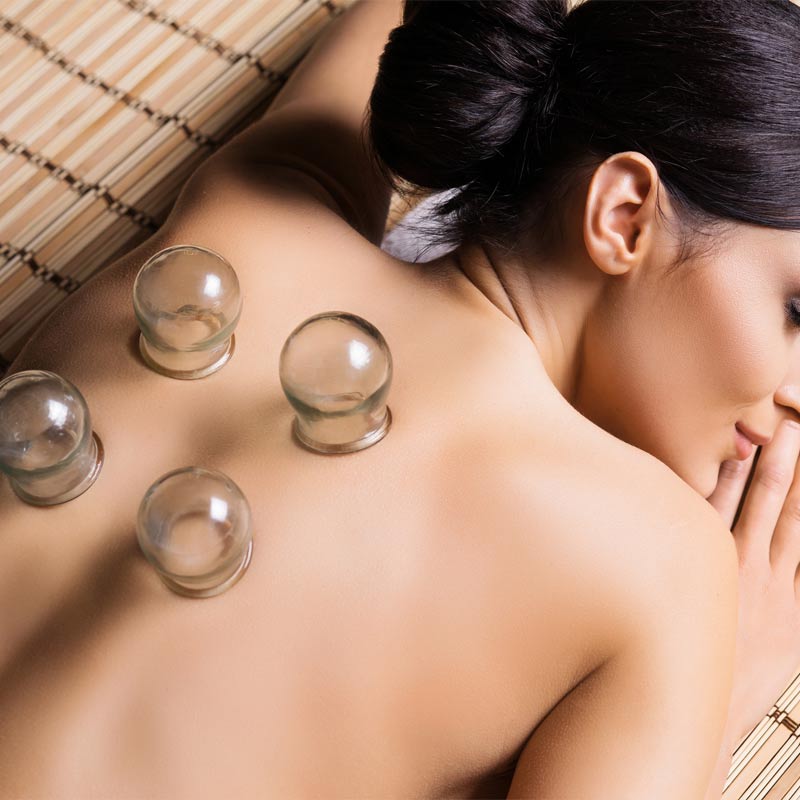
Cupping is a therapy in which a jar is attached to the surface of skin to cause local congestion through negative air pressure. It is also a complementary technique of acupuncture in TCM. Traditionally, this negative air pressure is created by removal of the air in the jar through rapid heating-up the air with a burning or flaming material. A small handy vacuum pump has also been used to create the negative pressure in a particularly manufactured jar. Cupping has the advantages of warming and promoting free flow of Qi in channels, diminishing swellings and pains, dispelling cold and dampness.
Acupressure/TuiNa
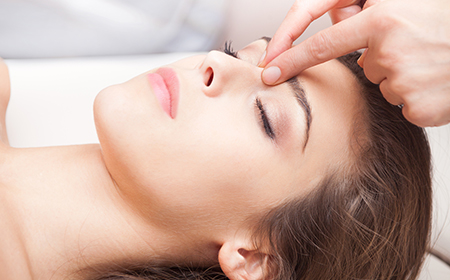 Acupressure or TuiNa is a physical therapeutic technique similar to massage. By applying appropriate pressure with certain specific hand-skills (e.g. rotating, rolling, pinching, etc.) onto acupoints, it has the functions of removing blockage of channels, facilitating flowing of Qi and blood, relieving pains and enhancing internal organ functions. In addition, acupressure may function as a diagnostic method as well, particularly when Ashi or pain points (where the local skin becomes hypersensitive to pressure or pinch) can be detected in certain specific locations (known channels or points). In this case, the sensitivity of Ashi points to acupressure also indicates the effectiveness of the treatment at certain degree.
Acupressure or TuiNa is a physical therapeutic technique similar to massage. By applying appropriate pressure with certain specific hand-skills (e.g. rotating, rolling, pinching, etc.) onto acupoints, it has the functions of removing blockage of channels, facilitating flowing of Qi and blood, relieving pains and enhancing internal organ functions. In addition, acupressure may function as a diagnostic method as well, particularly when Ashi or pain points (where the local skin becomes hypersensitive to pressure or pinch) can be detected in certain specific locations (known channels or points). In this case, the sensitivity of Ashi points to acupressure also indicates the effectiveness of the treatment at certain degree.
QiGong
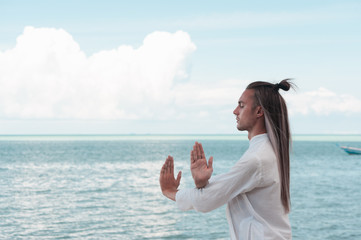 QiGong is one of the most powerful self-healing traditions ever developed in human history. The word QiGong breaks into Qi and Gong: Qi = vitality, energy, life force, Gong = practice, cultivate, refine; QiGong = to cultivate and refine through practice one’s vitality or life force. While QiGong has strong roots into mystical and philosophical ground, the practical healing and stress management applications are not only the most popular aspects of the tradition in China but also rapidly gaining in popularity in the Western world as people realize that disease and stress are relieved by peace of mind. Patients who use QiGong faithfully need less medication and heal faster. In the paradigm of mechanistic Western science, the practice of QiGong triggers a wide array of physiological mechanisms that have profound healing benefits. It increases the delivery of oxygen to the tissues, enhances the elimination of waste products, facilitates the transportation of immune cells through the lymph system and also shifts the chemistry of the brain and the nervous system. It is believed that the primary mechanism that is triggered by the practice of QiGong is a spontaneous balancing and enhancing of the natural healing resources in the human system. Such a self-balancing and healing function is part of human nature but normally inhibited by the cortex that is always preoccupied by endless high-priority duties–collecting and analyzing information and making decisions even during dreaming (randomly replaying, sorting and storing the daytime’s info). Therefore, if you are not too busy to give yourself a break (usually half hour/day) so as to create a temporal peace of mind, you are guaranteed to get faster healing and better health.
QiGong is one of the most powerful self-healing traditions ever developed in human history. The word QiGong breaks into Qi and Gong: Qi = vitality, energy, life force, Gong = practice, cultivate, refine; QiGong = to cultivate and refine through practice one’s vitality or life force. While QiGong has strong roots into mystical and philosophical ground, the practical healing and stress management applications are not only the most popular aspects of the tradition in China but also rapidly gaining in popularity in the Western world as people realize that disease and stress are relieved by peace of mind. Patients who use QiGong faithfully need less medication and heal faster. In the paradigm of mechanistic Western science, the practice of QiGong triggers a wide array of physiological mechanisms that have profound healing benefits. It increases the delivery of oxygen to the tissues, enhances the elimination of waste products, facilitates the transportation of immune cells through the lymph system and also shifts the chemistry of the brain and the nervous system. It is believed that the primary mechanism that is triggered by the practice of QiGong is a spontaneous balancing and enhancing of the natural healing resources in the human system. Such a self-balancing and healing function is part of human nature but normally inhibited by the cortex that is always preoccupied by endless high-priority duties–collecting and analyzing information and making decisions even during dreaming (randomly replaying, sorting and storing the daytime’s info). Therefore, if you are not too busy to give yourself a break (usually half hour/day) so as to create a temporal peace of mind, you are guaranteed to get faster healing and better health.
